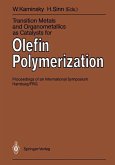For catalytic practitioners who are concerned with laboratory studies of reaction mechanisins, as often as not catalyst deactivation is· treated as a nuisance to be ignored or factored out of the experimental results. How ever, the engineer concerned with the design and opera tion of real catalysts and processes cannot afford this luxury: for him deactivation and the need for regenera tion are inevitable facts of life which need to be treated as quantified design parameters. The first chapter in this volume by Prof. J. B. Butt deals with catalyst deactivation and regeneration as processes in their own right, and shows how they are to be approached from kinetic and design points of view. Catalytic olefin polymerization spans a very wide field in catalytic process chemistry and technology. Processes of this sort range from the generation of high volume products such as polyethylene and polypropylene, through more specialized commercial products, to con versions that still remain laboratory curiosities. The reaction chemistry is, in detail, often very complex. However, because of the insight provided by organo metallic reaction chemistry, many of the polymerization mechanisms are reasonably well understood, and the way in which product stereospecificity may be obtained is also understood in considerable detail. This highly complex subject is reviewed in detail in the second chapter of this volume by Prof. I. Pasquon and Dr. G. Giannini.
Hinweis: Dieser Artikel kann nur an eine deutsche Lieferadresse ausgeliefert werden.
Hinweis: Dieser Artikel kann nur an eine deutsche Lieferadresse ausgeliefert werden.








